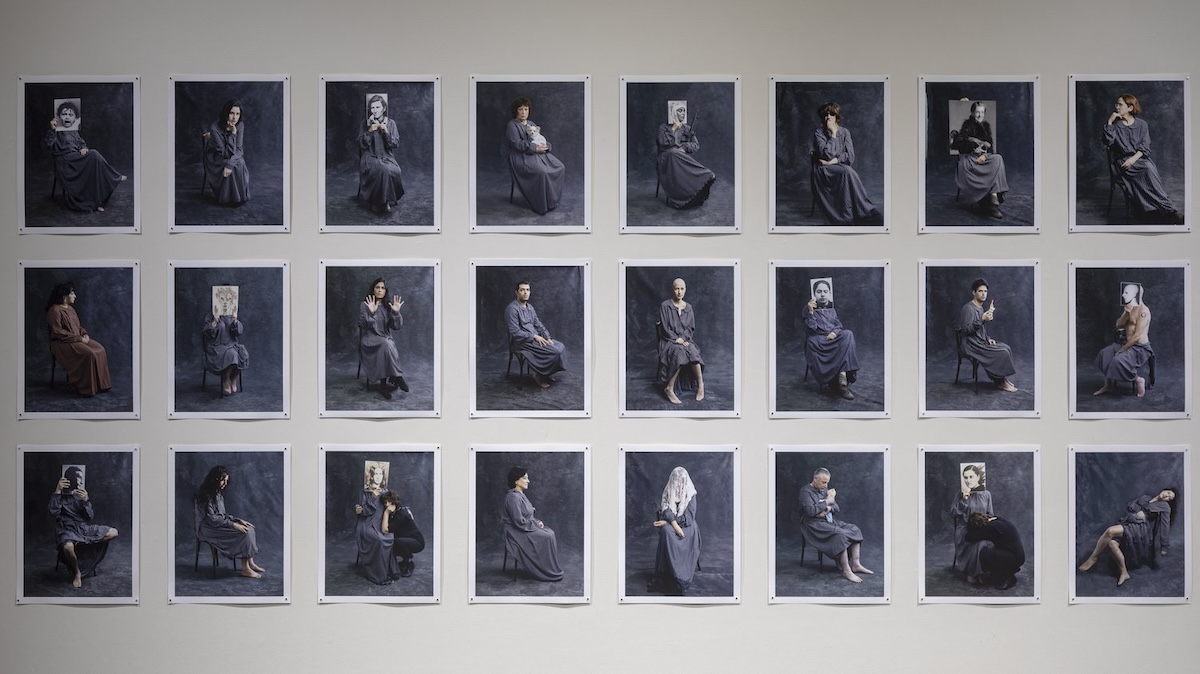Binghamton University Art Museum hosts Gradiva Award-winning exhibition
“Michal Heiman: Chronically Linked” was the largest exhibition of the artist’s work in the U.S.

For many surrealist painters, writers and famous psychoanalysts — Sigmund Freud, most notably — the name “Gradiva” refers to many things: A Pompeian bas-relief, a famous story, and an analysis of dreaming and delusions. For Michal Heiman, the name Gradiva can conjure up two more associations: the photograph of a woman who inspired her art, and the award she received for it.
The Binghamton University Art Museum hosted the exhibit “Michal Heiman: Chronically Linked” from Sept. 9, 2022, to Feb. 15, 2023. At its heart was a photograph Heiman discovered of a young woman taken around 1855 at the Surrey County Lunatic Asylum in London.
“The photograph completely affected me. It led me to a project seeking to contribute to envisioning the political, cultural, gendered and psychic conditions of women in asylums, and the possibilities of ’return’,” Heiman said. “The strategy of intervening in existing spaces — archives, photographs, films, works of art, historical events, case studies, diagnostic tests — breaking their silence, and using them as a platform for visual enactments and new concepts was not new to my practice, but it was a radical proposal to create a new community, comprised of dozens of photographs of women, asylum-seekers, activists and artists.”
The exhibition recently received the Gradiva Award from the National Association for the Advancement of Psychoanalysis (NAAP). Each year, the organization celebrates and acknowledges works that represent and promote psychoanalysis and psychotherapy.
“It’s called ‘Michal Heiman: Chronically Linked’ because her work builds from each new project,” said Claire Kovacs, the Art Museum’s curator of collections and exhibitions. “The show included photographs, video and sound components — and we also borrowed a set piece from the theatre department to round out the installation. As we conceived the show, we thought about how these artworks could exist in this space together.”
Investigating personal experiences and recovered “detritus,” Heiman’s conceptual works are grounded in photography, video and archival materials. Her projects, including “Radical Link: A New Community of Women, 1855-2021” (2013-present) and “Hearing” (2020), all consider the political, cultured and gendered conditions of “return” — both returns to the past and rights of return.
“Heiman’s work as an artist is conceptual. It’s not just a photograph for you to look at that’s very straightforward and you’re expected to draw A, B and C conclusions from it,” Kovacs said. “She means for you to engage with the work from wherever you’re coming from. All of us approach art from different perspectives. In many ways, she’s enacting a psychoanalytic framework in the engagement of the work itself.”
Heiman began her psychoanalyst work in 1994, with the work “Michal Heiman Test: Endopsychic Press,” at the University of Melbourne Museum of Art, Australia. She has continued that series, using her own procedures to administer and enact them in museum and theatre spaces. These installations are known as the Michal Heiman Tests or M.H.T.s, modeled after the Thematic Apperception Test (TAT), in which trained professionals interpret clients’ reactions to plates featuring ambiguous situations.
In these pieces, Heiman challenges and deconstructs these “tests” through her work, believing they can be dangerous tools.
“Essentially, you have somebody who’s trained in the artwork sit down with somebody who’s a volunteer, and they enact that process, like the Thematic Apperception Tests,” Kovacs said. “‘Here’s a photograph: What do you see here? What are your experiences?’ She has a whole framework planned out: that’s the experience of the art.”
“Michal Heiman: Chronically Linked” was the largest exhibition of Heiman’s work in the U.S. and brought together the M.H.T.s and some stand-alone pieces. Before the 2022 exhibition, Heiman had shown these works at the American University Center for the Arts and the Jewish American University.
To complete the experience, there was another exhibit on display in the Museum’s lower galleries focusing on works relating to Binghamton’s local connection: the New York State Inebriate Asylum, the first in the United States to treat alcoholism as a disease and not a social problem or a moral failing. In “Unconventional Care: The Mission of the NYS Inebriate Asylum,” Kovacs and Art Museum Director Diane Butler aimed to tell the story of the asylum and its residents through photographs of the now-vacant building. Heiman’s exhibition was also the site of select performances from Associate Professor of Theater Elizabeth Mozer’s play ‘The Asylum Project,” also based on the local asylum, connecting it to Heiman’s work through conversation.
Each year, the Art Museum puts together and displays two new exhibitions, and past shows have explored pieces in the University’s permanent collection as well as new work.
“There’s nothing like an original work of art in front of you,” Butler said. “That’s what it comes down to. Digital engagement is great for learning more things and getting to know more about an artisd or piquing your interest, but at heart, we’re a museum because we have real things made by real people.”




